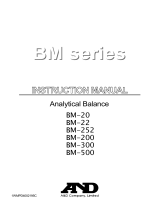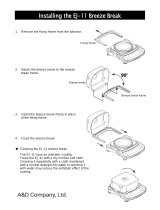
1
Contents
Basic Operation
1. INTRODUCTION .............................................................................................................................3
1-1 About This Manual .....................................................................................................................3
1-2 Features.....................................................................................................................................3
1-3 Compliance................................................................................................................................4
2. UNPACKING THE BALANCE..........................................................................................................7
2-1 Unpacking..................................................................................................................................7
2-2 Installing the Balance.................................................................................................................9
3. PRECAUTIONS.............................................................................................................................10
3-1 Before Use...............................................................................................................................10
3-2 During Use...............................................................................................................................10
3-3 After Use ..................................................................................................................................11
3-4 Power Supply...........................................................................................................................11
4. DISPLAY SYMBOLS AND KEY OPERATION ...............................................................................12
5. WEIGHING ....................................................................................................................................13
5-1 FZ-CT / FX-CT Series Balance................................................................................................13
5-2 Basic Operation (FZ-CT / FX-CT Series Balances) .................................................................13
5-3 FZ-GD / FX-GD Series Balances.............................................................................................14
5-4 Basic Operation (FZ-GD / FX-GD Series Balances) ................................................................14
ADAPTING TO THE ENVIRONMENT
6. RESPONSE ADJUSTMENT..........................................................................................................15
7. CALIBRATION...............................................................................................................................16
7-1 Calibration Mode......................................................................................................................16
7-2 Calibration Using the Internal mass (One-Touch Calibration, only for FZ-CT/GD series) ........17
7-3 Calibration Using an External Weight ......................................................................................18
7-4 Calibration Test Using an External Weight...............................................................................20
8. FUNCTION SWITCH AND INITIALIZATION..................................................................................22
8-1 Permit or Inhibit........................................................................................................................22
8-2 Initializing the Balance .............................................................................................................23
FUNCTIONS
9. FUNCTION TABLE ........................................................................................................................24
9-1 Structure and Sequence of the Function Table ........................................................................24
9-2 Display and Keys .....................................................................................................................24
9-3 Details of the Function Table....................................................................................................25
9-4 Description of the Class “Environment, Display”......................................................................28
9-5 Description of the Item “Data Output Mode” ............................................................................30
9-6 Description of the Item “Data Format”......................................................................................31




























